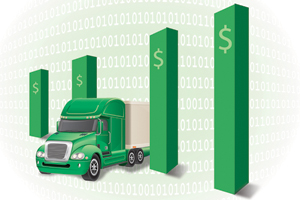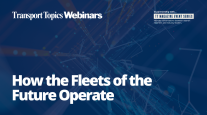Dollars and Data

This story appears in the November 14 print edition of iTECH, a supplement to Transport Topics.
Today’s financial reporting software is allowing carriers to go well beyond simply tracking accounts payable and accounts receivable. Now they can automatically pull in multiple data streams, compile information in a central location and analyze it in hundreds of ways to enable data-driven decision making.
Current software also improves accuracy with a series of checks and balances that flag anomalies while scanning and storing backup documentation.
“You have to be able to manage with data,” said Steve Cox, vice president at Oracle Corp. “You have to have something that can tell you what has happened, what is happening and what is likely to happen.”
BEST OF NOVEMBER iTECH: More stories, columns
Oracle’s finance function can pull data from within a fleet’s systems or from external sources. The base product can run 443 analytics and reports, and that can increase with additional Oracle products.
“The challenge is, now you can measure everything,” Cox said. “You have to know what you need to measure, and you have to be able to present data in a way that everybody can understand.”
TMW Systems Inc. integrates its transportation management software with Microsoft Dynamics GP to automate the workflow related to financial accounting. Data from TMW flow into the system to automate invoices and match purchase orders and receipts with expenses.
“It eliminates the paperwork shuffle,” said Kevin Meyer, consulting manager at TMW.
TMW users can scan an invoice when it arrives. Then the software uses optical character recognition to identify the vendor and store the data in the system.
Covenant Transport uses TMW’s integration with Microsoft Dynamics GP for its accounting system.
Paul Bunn, Covenant’s chief accounting officer, said his top priority for his company’s accounting software is being able to pull timely, accurate information and quickly import or export data.
“The GP SmartList queries are perfect for doing this,” he said. “Each employee can customize the information they need and has data at their fingertips whenever they need it.”
Bunn said the software will warn users if there is a duplicate invoice for a vendor.
Covenant Transportation Group, based in Chattanooga, Tennessee, ranks No. 43 on the Transport Topics Top 100 list of the largest for-hire carriers in the United States and Canada.
Another carrier, Minstar Transport, uses financial reporting from McLeod Software to drill down into profitability by customer and lane.
“It has everything you’d ever want to know about your revenue and how much you’re making on every single load in every single area,” said Carena Kelz, accounting supervisor at the Eagan, Minnesota-based fleet. “You can single it out by city, state or ZIP code. You can see certain times of the year, trends and the deadheads.”
To help manage owner-operators, Minstar uses the software to automatically collect data on fuel, load tenders and tolls.
“You can have them filter in as an expense or a liability and charge the driver back if it is an owner-operator,” Kelz said.
Robert Brothers, McLeod’s manager of product development, said different users want to correlate data in different ways.
“We create different data dimensions to tie data to a quarter or customer, driver or tractor-trailer, and you can create your own reports using a whole host of third-party tools to look at your data,” he said.
Housing all of the data in one place makes it easier to access and find answers.
“By having those systems all in one product, we create the ability to tie things from order entry through the general ledger detail,” Brothers said, adding that McLeod can draw on data that are nonfinancial in nature, such as miles or number of drivers.
JA Frate, a less-than-truckload and airfreight carrier based in McHenry, Illinois, uses software from Carrier Logistics Inc. to manage its finances.
“It allows you to manage all of your shipments in one place. You have visibility and slice and dice it in many different ways — drivers, routes, customers,” said Kathleen Anderson, the fleet’s office manager.
Financial software has made managing and accessing data easier on all fronts, she said.
“It is up to the users to use it correctly, but if everybody does, it makes it easy to review the information and provide the details to the customer,” Anderson said.
In many of the systems, including CLI’s software, the flow of data starts once an order is created. Information is added throughout the life of a shipment, either using updates from the driver or information fed in electronically, such as fuel purchases and tolls. If there are discrepancies in the data, the system flags the potential errors.
“Customers today require invoices to be accurate because they are going into systems that are electronic and automatically making payments,” CLI Executive Vice President Ken Weinberg said.
The systems also allow users to customize their invoices and attach supporting documentation based on customer demands.
“We’re trying to satisfy their requests and speed up the cash flow. We want the invoice to get to the customer as soon as possible so they will pay it,” Weinberg said, adding that errors can slow the process. “You immediately add 30 days to it if it comes back.”
CXI Trucking, based in Melrose Park, Illinois, uses CLI software to automatically rate invoices, which ensures pricing is accurate.
“We used to rate everything manually, meaning we had a huge book on our desk with all of our customers. That leaves a lot of room for error, and it is time consuming,” said Kimberly Morosky, CXI’s office manager.
Now Morosky can create a specific tariff, such as a pallet rate, for a customer when entering the information into the system and configure additional charges.
“The accessorial charges are adjusted on the fees and can be tailored to the unique requirements of the customers,” Weinberg said.
Morosky said using CLI saves time when looking up specific information for a customer, such as a check number, and allows users to track a driver’s location based on the information he or she has updated.
“Instead of having to transfer the call to dispatch, anyone in customer service can track the load and see what the driver’s [estimated time of arrival] is,” she said.
Morosky said many customers want additional documents with an invoice.
“Not only do you have the statement and invoice in one place, you have backup documentation,” she said.
With software from Axon Development Corp., carriers can manage driver pay, mileage, recurring expenses, insurance expenses, plate expenses and depreciation.
“Management can run reports to see exactly which truck is making money and which isn’t,” said Jason Kretzer, vice president at Axon.
The software provider has a built-in work order inventory so customers can track expenses from their own shop or an outside vendor to identify the full cost of an asset, he said.
Breaking down expenses by asset also can help carriers identify problem areas.
Kretzer said, “If a truck is using an excessive amount of fuel, does the driver need training? Is he stealing?”
Since the systems continually update, they provide insight into customers’ credit limits before it is too late. Axon sends alerts if a customer is over its credit limit.
“Even if the order hasn’t been invoiced, we keep track of what is pending so the dispatchers don’t book 10 to 15 loads and then realize they’re over their credit limit,” Kretzer said.
Financial software also makes it easier to manage driver pay and speed up the process, carriers said.
With Axon, drivers scan their documents at the last stop and payroll receives an alert that the paperwork is complete.
“We have the revenue codes set up, and the system automatically starts the process,” Kretzer said, adding that once a driver is added to an order, it automatically calculates his pay. “If there is a recurring expense, pre-paid insurance and so forth, you set it up once and it automatically updates.”




